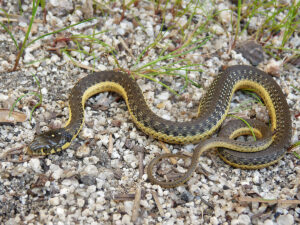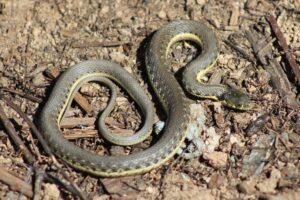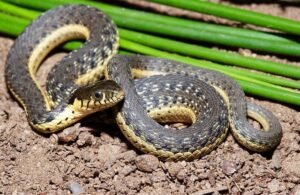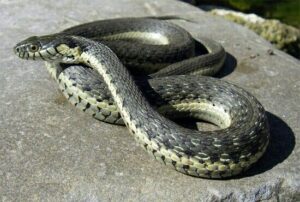The two-striped garter snake is a medium-sized aquatic garter snake species native to western North America. The specific name hammondii is in recognition of William A. Hammond, the US army surgeon who collected the first specimens. Though primarily diurnal, it can be active at dusk and night during the hot summer days.
Scientific Classifications
- Suborder:Serpentes
- Family:Colubridae
- Genus:Thamnophis
- Species:T. hammondii
Conservation Status
Description
Size
The snake’s total length, including the tail, is 18-30 in (45.72-76.2 cm).
Color and Appearance
There are two common color variations of the species in the wild – a striped and a checkered variant. The striped variant has a fairly uniform dorsal color with a yellowish lateral stripe on each side. The checkered variant has two rows of small dark spots on each side instead of the lateral stripes. The head is not much wider than the neck.
Are They Dangerous to Humans
When picked up, the two-striped garter snake strikes repeatedly releasing musk and cloacal contents. It produces a mild venom that is deadly to its small prey but not dangerous to humans. When threatened, it assumes a defensive posture with its head flattened into a triangular shape resembling highly venomous snakes like rattlesnakes.
Two-striped Garter Snakes at a Glance
Distribution
This garter snake inhabits western North America, ranging from central California to Baja California in Mexico.
Habitat
The highly aquatic species prefers places adjacent to semi-permanent and permanent water bodies like creeks, pools, cattle tanks, etc., and is often found in rocky areas. The associated vegetation is usually willow, oak woodland, coastal sage scrub, sparse pine, scrub oak, brushland, and chaparral.
Lifespan
Their lifespan in the wild is unknown. But they can live for 7-10 years in captivity.
Predators
Birds, mammals, and other snakes are its predators.
Diet
Fish and amphibians mainly form its diet. The two-striped garter snake eats tadpoles, newt larvae, fish, fish eggs, small toads and frogs, earthworms, and leeches.
Reproduction
Ovoviviparous (gives birth to live young from eggs that hatch inside the body)
Late March and early April are when they mate. A female gives birth to a litter of 15 young from July to October. She stores sperm for later use.
Source
pinglelist.org, eol.org, flickr.com









